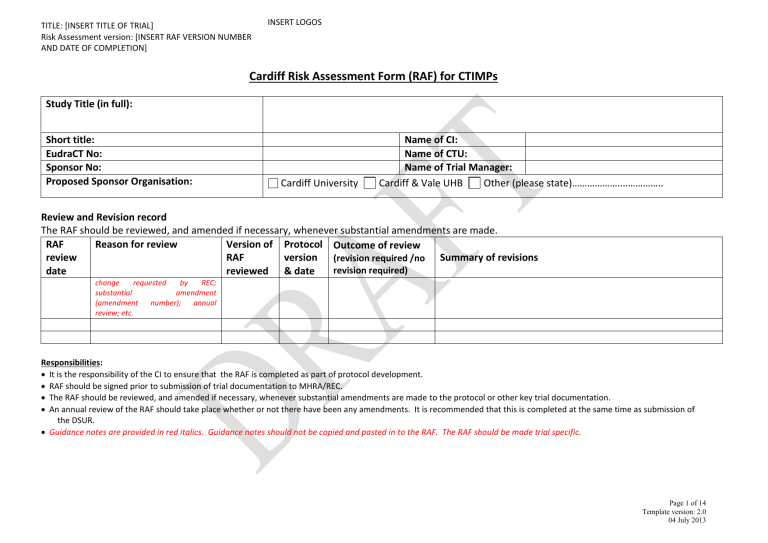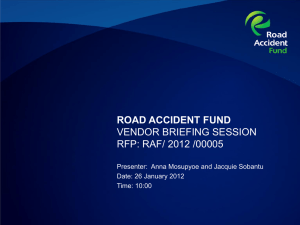Template CTIMP Risk Assessment Form v2.0

TITLE: [INSERT TITLE OF TRIAL]
Risk Assessment version: [INSERT RAF VERSION NUMBER
AND DATE OF COMPLETION]
INSERT LOGOS
Cardiff Risk Assessment Form (RAF) for CTIMPs
Study Title (in full):
Short title:
EudraCT No:
Sponsor No:
Proposed Sponsor Organisation:
Name of CI:
Name of CTU:
Name of Trial Manager:
Cardiff University Cardiff & Vale UHB Other (please state)……………….……………..
Review and Revision record
The RAF should be reviewed, and amended if necessary, whenever substantial amendments are made.
RAF review date
Reason for review Version of
RAF reviewed
Protocol version
& date
Outcome of review
(revision required /no revision required)
Summary of revisions change requested by REC; substantial amendment
(amendment number); annual review; etc.
Responsibilities:
It is the responsibility of the CI to ensure that the RAF is completed as part of protocol development.
RAF should be signed prior to submission of trial documentation to MHRA/REC.
The RAF should be reviewed, and amended if necessary, whenever substantial amendments are made to the protocol or other key trial documentation.
An annual review of the RAF should take place whether or not there have been any amendments. It is recommended that this is completed at the same time as submission of the DSUR.
Guidance notes are provided in red italics. Guidance notes should not be copied and pasted in to the RAF. The RAF should be made trial specific.
Page 1 of 14
Template version: 2.0
04 July 2013
TITLE: [INSERT TITLE OF TRIAL]
Risk Assessment version: [INSERT RAF VERSION NUMBER
AND DATE OF COMPLETION]
INSERT LOGOS
IMP Risk Categorisation
Risks associated with trial IMP/interventions:
(see appendix 1 for categorisation)
Type A = Comparable to the risk of standard medical care
Type B = Somewhat higher than the risk of standard medical care
Type C = Markedly higher than the risk of standard medical care
Justification
Phase of development o Study population: healthy subjects or patients? o If IMP is licensed, is it being used outside its licensed indication? Has the dosage regimen/route been modified? o If so, what are the implications of any modifications for participants
Safety profile o What are the known/anticipated safety issues? Are they all addressed within normal clinical practice
(standard care)? o If unknown, what are the anticipated risks/other effects based on preclinical data or knowledge of class of drugs? o Is the duration of use compatible with previous experience? o Is there a potential risk for dosing errors?
May concomitant medications increase the risk, i.e. interactions?
Additional safety monitoring in comparison to standard care?
Are any other risk mitigation strategies necessary (restrictive eligibility criteria; treatment protocol (timing of dose, location of administration, availability of rescue medication); criteria for stopping or modifying study treatment; AE reporting strategy; duration of exposure and follow-up; Trial Oversight)
Where risks associated with the IMP/intervention are somewhat or markedly higher than the risk of standard care (i.e. Type B or C trials) details regarding specific risks to body systems and proposed methods for clinical monitoring of such risks should be described below.
Measures and controls where the risk of the intervention is considered to be comparable to standard care (i.e. Type A) need not be spelled out in detail. However basic assumptions about routine monitoring and consideration should be summarised as part of the justification provided.
IMP/Intervention Body system Potential Toxicities Mitigation strategies described in the protocol
Page 2 of 14
Template version: 2.0
04 July 2013
TITLE: [INSERT TITLE OF TRIAL]
Risk Assessment version: [INSERT RAF VERSION NUMBER
AND DATE OF COMPLETION]
INSERT LOGOS
Outline any other processes that have been put in place to mitigate risks to participant safety
RISK/HAZARD Is there a particular risk
(Yes / No)
Considerations/Concerns
Identified
Provide details of trial-specific considerations/risk concerns
Mitigation Strategies / Adaptations to minimise the hazard:
Address all concerns identified
Provide details of any risk-adaptations to conventional GCP management strategies employed
Refer to appendix 2 for further guidance
Additional monitoring methods required:
discuss impact on trial monitoring requirements
1. TRIAL PARTICIPANTS
1.1 Hazards of clinical procedures specified in protocol
Do the procedures differ from standard care (e.g. increased radiological exposure, additional biopsies,
Questionnaires involving ‘sensitive’ subject areas, Contact with harmful chemicals, substances, equipment or organisms)?
1.2 Non-compliance with informed consent process
Is the consent process complex (e.g.
multiple consent forms)?
Does the study population involve vulnerable groups?
Will participants have capacity to give consent?
Will there be sufficient time to consider information (e.g. consent in an emergency setting)?
Page 3 of 14
Template version: 2.0
04 July 2013
TITLE: [INSERT TITLE OF TRIAL]
Risk Assessment version: [INSERT RAF VERSION NUMBER
AND DATE OF COMPLETION]
RISK/HAZARD Is there a particular risk
(Yes / No)
INSERT LOGOS
Considerations/Concerns
Identified
Provide details of trial-specific considerations/risk concerns
Does the person taking consent have
sufficient experience and knowledge?
Is there a process for acting on patient request to withdraw from trial?
1.3 Failure to protect participants’ privacy
Will sensitive data be collected?
Are data collection methods secure (e.g. recording of qualitative interviews)?
Does trial involve use of a diary card?
Will transfer of data be secure?
Will data be transferred between organisations?
Will identifiable data be transferred to third parties?
Will data be sent outside UK?
Will participants be paid travel expenses?
1.4 Other please give details:
2. VALIDITY OF RESULTS:
2.1 Study inadequately powered
Will the study have sufficient power to detect the anticipated treatment effect?
Is the recruitment target feasible
(restricted access to patients, insufficient patient pool, adequate time scale, and competing trials)?
Is the treatment effect plausible?
Might the inclusion/exclusion criteria be too restrictive?
Will there be sufficient statistical input
and ongoing support?
Mitigation Strategies / Adaptations to minimise the hazard:
Address all concerns identified
Provide details of any risk-adaptations to conventional GCP management strategies employed
Refer to appendix 2 for further guidance
Additional monitoring methods required:
discuss impact on trial monitoring requirements
Page 4 of 14
Template version: 2.0
04 July 2013
TITLE: [INSERT TITLE OF TRIAL]
Risk Assessment version: [INSERT RAF VERSION NUMBER
AND DATE OF COMPLETION]
RISK/HAZARD Is there a particular risk
(Yes / No)
INSERT LOGOS
Considerations/Concerns
Identified
Provide details of trial-specific considerations/risk concerns
2.2 Major Violation of eligibility criteria
Does the trial require very prescriptive eligibility criteria?
Will confirmation of eligibility require special/complex assessments?
Will Inexperienced/untrained staff be carrying out eligibility assessments?
2.3 Lack of robust randomisation procedure
Is there a possibility of unbalanced/incorrect randomisation?
Is there a risk of prediction of treatment allocation when entering patients?
2.4 Potential for loss of blinding
Will there be a robust Emergency
unblinding procedure?
Is the unblinding procedure complex?
Are the IMP and placebo distinguishable?
Could a clinical event effectively unblind the patient?
Is there a robust unblinding procedure for reporting of SUSARs?
2.5 Unreliable outcome Assessment
Are there key outcomes which require subjective or complex assessment?
Is there a risk of poor data quality?
Will source data be available for verification e.g. death certificate, laboratory investigation result?
Will equipment be calibrated?
Is there a risk to completeness of follow-
Mitigation Strategies / Adaptations to minimise the hazard:
Address all concerns identified
Provide details of any risk-adaptations to conventional GCP management strategies employed
Refer to appendix 2 for further guidance
Additional monitoring methods required:
discuss impact on trial monitoring requirements
Page 5 of 14
Template version: 2.0
04 July 2013
TITLE: [INSERT TITLE OF TRIAL]
Risk Assessment version: [INSERT RAF VERSION NUMBER
AND DATE OF COMPLETION]
RISK/HAZARD Is there a particular risk
(Yes / No)
INSERT LOGOS
Considerations/Concerns
Identified
Provide details of trial-specific considerations/risk concerns
2.6 Unreliable data collection
Are Sites familiar with the data collection method?
Has the CRF been approved?
Has the eCRF been tested and approved?
Is there a risk of poor data quality? up, i.e. is the follow up schedule difficult?
2.7 Poor Data Management system
Is there a risk of poor data quality?
Has the database been specified and tested?
Will the database be secure?
Is the data complex?
2.8 Other please give details:
3. TRIAL MANAGEMENT:
3.1 Inexperienced Trial Staff
Are the Clinical teams experienced with the intervention?
Are the Clinical teams experienced with
CTIMPs?
Will the trials teams receive sufficient training?
3.2 Competence of Partner
Organisations
Will the trial involve multiple Sites?
Will key functions be performed by partner organisations (e.g. central
Mitigation Strategies / Adaptations to minimise the hazard:
Address all concerns identified
Provide details of any risk-adaptations to conventional GCP management strategies employed
Refer to appendix 2 for further guidance
Additional monitoring methods required:
discuss impact on trial monitoring requirements
Page 6 of 14
Template version: 2.0
04 July 2013
TITLE: [INSERT TITLE OF TRIAL]
Risk Assessment version: [INSERT RAF VERSION NUMBER
AND DATE OF COMPLETION]
RISK/HAZARD Is there a particular risk
(Yes / No)
INSERT LOGOS
Considerations/Concerns
Identified
Provide details of trial-specific considerations/risk concerns laboratory, randomisation and unblinding, IMP management)?
Are responsibilities and liabilities of partner organisations clear?
3.3 Inadequate Trial Management
Are key responsibilities defined?
Is the central trial management team sufficiently experienced?
3.4 Appropriate resources not available
Have the research and treatment costs been fully costed?
Has the cost of continuation of drugs after research has finished been considered?
Is there a risk of withdrawal of funding?
Is there a direct impact on Clinical
Services via tests required?
Is there an indirect impact on Clinical
Services via staff time?
Do all Sites have the infrastructure to support the trial?
Is the funding source secure?
3.5 Inadequate Pharmacovigilance systems
Is the SAE reporting form/process complex?
Will there be an SAE monitoring and review process?
Are Sites and trial management team familiar with SAE reporting requirements?
Mitigation Strategies / Adaptations to minimise the hazard:
Address all concerns identified
Provide details of any risk-adaptations to conventional GCP management strategies employed
Refer to appendix 2 for further guidance
Additional monitoring methods required:
discuss impact on trial monitoring requirements
Page 7 of 14
Template version: 2.0
04 July 2013
TITLE: [INSERT TITLE OF TRIAL]
Risk Assessment version: [INSERT RAF VERSION NUMBER
AND DATE OF COMPLETION]
RISK/HAZARD Is there a particular risk
(Yes / No)
INSERT LOGOS
Considerations/Concerns
Identified
Provide details of trial-specific considerations/risk concerns
Are there systems to maintain awareness of and to act on new knowledge?
Will participants be able to report adverse events and study outcomes reliably?
3.6 Poor IMP management systems
Is it clear which drugs are classed as
IMPs?
Is the Supply of IMP from the drug company secure?
Are IMP storage systems adequate?
Is there appropriate control of IMP
release to Sites?
Are IMP handling instructions for Sites clear (potential for dosing errors, temperature deviations, etc)?
Is there potential for interruption to or change in standard of care?
Is standard of care likely to be different between Sites?
3.7 Poor sample management
Is the sample management process complex?
Are samples being sent to multiple
laboraites?
Are sites familiar with sample collection and transfer requirements?
3.8 Influence/interference of private organisation upon trial governance
Could there be a breach of patient confidentiality via inappropriate access
Mitigation Strategies / Adaptations to minimise the hazard:
Address all concerns identified
Provide details of any risk-adaptations to conventional GCP management strategies employed
Refer to appendix 2 for further guidance
Additional monitoring methods required:
discuss impact on trial monitoring requirements
Page 8 of 14
Template version: 2.0
04 July 2013
TITLE: [INSERT TITLE OF TRIAL]
Risk Assessment version: [INSERT RAF VERSION NUMBER
AND DATE OF COMPLETION]
RISK/HAZARD Is there a particular risk
(Yes / No)
INSERT LOGOS
Considerations/Concerns
Identified
Provide details of trial-specific considerations/risk concerns to data / results?
Could external organisation misinterpret results?
Is ownership of data and Intellectual
Property clear?
Are other organisations involved in trial design?
3.9 (viii) Other please give details:
e.g. is there a process for identifying and acting on potential serious breaches of GCP?
Summary of the main issues to be considered in the monitoring plan:
Mitigation Strategies / Adaptations to minimise the hazard:
Address all concerns identified
Provide details of any risk-adaptations to conventional GCP management strategies employed
Refer to appendix 2 for further guidance
Additional monitoring methods required:
discuss impact on trial monitoring requirements
Page 9 of 14
Template version: 2.0
04 July 2013
TITLE: [INSERT TITLE OF TRIAL]
Risk Assessment version: [INSERT RAF VERSION NUMBER
AND DATE OF COMPLETION]
INSERT LOGOS
Authorisation: This section is to be signed once all risks and risk management strategies have been agreed
CI CTU
Name of CI Name of CTU representative
Sponsor
Name of Sponsor representative
Signature
Date
Signature
Date
Signature
Date
Additional authorisations (please insert details):
[xxxx]
Name
Signature
Date
[xxxx]
Name
Signature
Date
[xxxx]
Name
Signature
Date
Page 10 of 14
Template version: 2.0
04 July 2013
TITLE: [INSERT TITLE OF TRIAL]
Risk Assessment version: [INSERT RAF VERSION NUMBER
AND DATE OF COMPLETION]
INSERT LOGOS
Appendix 1 – Risk Level Categorisation for CTIMP trials
Is the product licensed in any EU member State?
No
Yes
Will the IMP be used in its licensed indication, dosage and form?
Or is off label use established practice and supported with published evidence?
Yes
Will the IMP be used in a combination for which interactions are suspected?
No
Yes
No
Is the active substance part of a medicinal product license in the EU?
Yes
No
Type A* Type B* Type C**
* A grading of TYPE A may be justified if there is extensive clinical experience with the product and no reason to suspect a different safety profile in the trial population
** A grading other than TYPE C may be justified if there is extensive class data or pre-clinical and clinical evidence.
If grading other than those indicated is felt to be justified the rationale and evidence should be presented in the CTA application
Page 11 of 14
Template version: 2.0
04 July 2013
TITLE: [INSERT TITLE OF TRIAL]
Risk Assessment version: [INSERT RAF VERSION NUMBER
AND DATE OF COMPLETION]
Appendix 2
Guidance notes should not be ‘copied and pasted’ in to the RAF. The RAF mitigation and management strategies should be made trial specific.
RISK/HAZARD Potential Mitigation /Management Strategies.
1.
1.1
1.2
Trial Participants
Hazards of clinical procedures specified in protocol
Non-compliance with informed consent process
INSERT LOGOS
Data Monitoring and Ethics Committee
IRMER / ARSAC review
Adverse event reporting systems
Performed by trained staff
Provision for containment, shielding, monitoring, etc.
1.3 Failure to protect participants’ privacy
Training and awareness-raising
Supervision of consent process
Re-consent throughout trial
Consent taken by treating clinician only
Assessment of capacity
Communication systems e.g. alerts stickers in patient notes, contact details on consent form
Collect signed consent forms in Site TMF
Confirmation of consent prior to randomisation
Audit of consent procedures including verification of signed consent forms in clinic records
Withdrawal procedure defined in protocol
Use of a withdrawal case report form
withdrawal criteria are clear
Adherence to normal NHS / University systems
Anonymised or anonymised/linked data
Minimise staff who have access to confidential information
Training and awareness-raising
Computer security systems
Fully auditable database
Use of encrypted media
specific consent for data transfer, payment of travel expense, etc.
RISK/HAZARD Potential Mitigation /Management Strategies.
2. VALIDITY OF
RESULTS:
2.1 Study inadequately powered
2.2
2.3
2.4
Major Violation of eligibility criteria
Lack of robust randomisation procedure
Potential for loss of
Statistical input to design and power
Recruitment assessment
Pilot studies
External communication and trial promotion
monitoring recruitment rates
Training in consent process
Trial steering Committee
Trial management group
Initiation training covering eligibility criteria
Eligibility criteria detailed in protocol and protocol available at every research site
Pilot study demonstrating suitability of eligibility criteria
Eligibility criteria verified prior to randomisation
On site monitoring to cover eligibility criteria
standard process for assessing eligibility queries
Use of well designed CRFs
randomisation system tested before implementation
IDMC to review balance between trial arms periodically
independent central randomisation
Trial specific randomisation procedure
Trial specific unblinding procedures – refer to point 2.4
Independent randomisation
Page 12 of 14
Template version: 2.0
04 July 2013
TITLE: [INSERT TITLE OF TRIAL]
Risk Assessment version: [INSERT RAF VERSION NUMBER
AND DATE OF COMPLETION]
2.5
2.6
2.7 blinding
Unreliable outcome
Assessment
Unreliable data collection
Poor Data
Management system
INSERT LOGOS
Access to randomisation schedule controlled (including for unblinding SUSARs, emergency unblinding, etc.)
Documented emergency unblinding procedure
Use of emergency code break envelopes
Detailed in protocol
Placebo formulated to match the IMP
Well defined objective end point
Standardised data collection forms
Training in CRF completion
Data Monitoring Committee
Trial Management Protocol
Central data monitoring
Statistical input to data monitoring and audit
Source Data Verification
Detailed in protocol
Equipment calibration and maintenance contracts
Standardised data collection forms
Training in CRF completion and data entry
Data Monitoring Committee
Central data monitoring
Source Data Verification
Standardised data collection forms
Training in CRF completion and data entry
Trial specific Data Management SOP
Statistical input in to central data monitoring
Statistical analysis in accordance Statistical analysis plan
Data encryption for all portable media
Specification document and system validation and testing all recorded
Database backup (use of centrally supported systems)
Restricted access to database
Traceability for all data corrections
Detailed in protocol
Data Monitoring Committee
Data quality checks (inc SDV)
RISK/HAZARD
3. TRIAL
MANAGEMENT:
3.1 Inexperienced Trial
Staff
3.2 Competence
Partner
Organisations of
Potential Mitigation /Management Strategies.
requirements)
Assess training needs of research team
PIs to submit SSI forms to NHS R&D for approval
systems to maintain awareness of and to act on new knowledge
Investigator meeting to review trial and procedures
Local Investigator(s) to sign protocol/declaration
Project team meetings
CVs for trial staff held in Trial Master File
Detailed training logs
Site registration process (inc checking trial assurance processes)
Trial coordinator/manager
Site visits
Investigator initiation meetings
Site and collaborator agreements
Monitoring of collaborating sites
Delegated responsibilities clearly identified and agreed in site file (including supervision
Experienced trial coordinating team
Delegated responsibilities clearly identified and agreed in site file (including supervision requirements)
Systems to ensure reporting obligations for medicinal trials (SUSARs, amendments, termination)
Page 13 of 14
Template version: 2.0
04 July 2013
TITLE: [INSERT TITLE OF TRIAL]
Risk Assessment version: [INSERT RAF VERSION NUMBER
AND DATE OF COMPLETION]
3.3
3.4
3.5
3.6
3.7
Inadequate
Management
Appropriate resources available
Inadequate
Trial not
Pharmacovigilance systems
Poor management systems
IMP
Influence/interferenc e of private organisation upon trial governance
INSERT LOGOS
Partner competency assessment
Roles and responsibilities MoU in place
SOPs in place
Trial Steering Committee
Regular GCP training (every 2 years) for Trial management team
Regular trial management group meetings
Trial delegation log
Internal quality assurance audits
Use of a Clinical Trials Unit
Trial costed via RACD
Contract with funding body
Contact with service early in planning and throughout the trial
Trial uses routine clinics
NHS R&D approval
Training in SAE reporting
Multidisciplinary project teams
Pharmacovigilance procedures detailed in protocol
Standardised SAE report form
SAE reporting / assessment checklist used by coordinating centre for each SAE
Reminder system to ensure Annual safety reports sent to MHRA and PIs
Additional Pharmacovigilance telephone calls to Sites
Data Monitoring and Ethics Committee
Dedicated Pharmacovigilance staff
Contract with IMP supply organisation including provisions for ensuring constant supply
All IMP orders processed via coordinating centre
IMP handling instructions detailed in protocol
Accountability records obtained regularly from Sites
Central accountability log maintained
process for dose escalation/reduction described in the protocol o Conflicts of interest declared o All organisations involved sign up to Trial Agreements
Page 14 of 14
Template version: 2.0
04 July 2013





